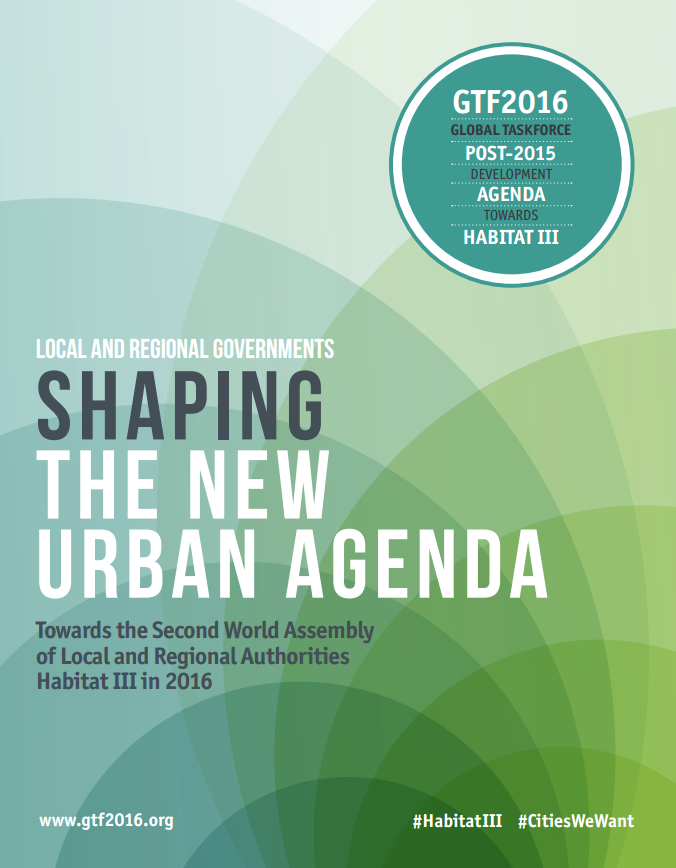Habitat III: Exciting times ahead!
01.04.2015
Where will you be during the week of 17 October 2016? If you are an urbanist, you will undoubtedly be at the HabitatIII conference in Quito, Ecuador, either physically or virtually.

By Eugénie L. Birch, Eugénie is Lawrence C. Nussdorf Professor of Urban Research and Education, Chair of the Graduate Group in City and Regional Planning, and Co-Director of Penn IUR
Where will you be during the week of 17 October 2016? If you are an urbanist, you will undoubtedly be at the HabitatIII conference in Quito, Ecuador, either physically or virtually.
This once-every-20-year meeting comprising the entire United Nations system — formally it is the U. N.Conference on Housing and Sustainable Urban Development — promises to be both exciting and productive.
It will be the first such convening of the U. N.’s 193 member states after the General Assembly, in September 2015, approves the new Sustainable Development Goals, likely including a hard-fought marker on cities. It will also be the first major summit after the world’s governments are expected to agree on a major new accord around climate change, in Paris in December 2015. Finally, the Habitat III conference will be the first global meeting on cities to take place since the global population tipped to majority urban, clearly a major turning point.
So as we look into the future, what outcomes can we expect from this landmark session? First and foremost, the United Nations, in its role as “guardian” of the international development agenda, says it will issue a “coherent approach to urbanization” in response to today’s unsustainable patterns of city growth.
Eight principles will guide these envisioned results, officially dubbed the New Urban Agenda. In accordance with these principles, this new agenda will, for instance, aim to be be both universal and innovative but also adapted to local contexts. It will recognize human rights, equity and the empowerment of civil society, while integrating broadly defined objectives of sustainability — economic, social and environmental. Critically, these objectives will seek to involve government units at multiple levels, not just the national.
The New Urban Agenda will also aim to incorporate a new model of urbanization built on nine transformative “levers”. These include country-specific urban policies rooted in economic productivity, gender equity and culture. In turn, such policies will be meant to create an enabling environment — in terms of both governance legislation and finance — that promotes territorial planning and urban design.
The end result is, hopefully, cities with basic public goods and adequate housing. In a phrase, the vision is “sustainable urbanization”.

Broadening participation
Second, if all goes well in the preparations leading up to the October 2016 meeting and at the conference itself, we will see considerable evidence of inputs from a variety of groups in detailing the vision. However, the challenge for Habitat III organizers and for the potential contributors, who comprise a wide range of civil society stakeholders, U. N.agencies and others, will be in finding effective channels through which to bring these ideas to the member states’ attention.
Remember, the official drafters of Habitat III’s New Urban Agenda will be nation states and no one else. While such a procedure is to be expected of an organization comprised of countries, these states alone do not possess the necessary expertise to create the New Urban Agenda. Instead, they will need to rely on the knowledge and wisdom of citizens, interest groups and a broad spectrum of experienced practitioners, ranging from community organizers to parliamentarians to local government officials and urban professionals.
The General Assembly did indeed recognize this need in 2012. At that time, it “encouraged effective contributions from and the active participation of all relevant stakeholders … at all stages of the preparatory process and at the Conference itself.” However, the assembly did not detail how to accomplish this goal.
With its authorization of Habitat III in 2009, the General Assembly did establish a secretariat, charged with logistics and programming, as well as a 10-member oversight bureau. (It actually created a preparatory committee that in turn delegated authority to the smaller bureau made up of representatives from Senegal, Chad, the UAE, Indonesia, the Czech Republic, Hungary, Chile, Ecuador, France and Germany.) The General Assembly called for these groups to devise ways to find and use the expert voices needed to help craft the New Urban Agenda.
States alone do not possess the necessary expertise to create the New Urban Agenda. Instead, they will need to rely on the knowledge and wisdom of citizens, interest groups and a broad spectrum of experienced practitioners, ranging from community organizers to parliamentarians to local government officials and urban professionals.
The secretariat subsequently produced a Roadmap Towards Habitat III, though the bureau has yet to approve all aspects of the plan. Running through the entire process are three preparatory committees (PrepComs). The first was held last September in New York and the second will take place in April in Nairobi.
The roadmap also lays out three vehicles for stakeholder contributions. The first of these will be national reports written by individual member states. Actually these reports will be written by committees formally appointed by each national government — bodies that may or may not include non-governmental stakeholders.
The second way that stakeholders will be able to formally contribute to the Habitat III process will be through “policy unit” reports. These will be written by United Nations agencies as well as partners selected by them
And third, this process will include engagement activities carried out by, for instance, the biannual World Urban Forums, the World Urban Campaign and the General Assembly of Planners. Notably, the World Urban Campaign (which I currently chair) conceived of the General Assembly of Partners (GAP) as a global deliberative mechanism by which non-governmental partners can forge consensus on common interests.
The GAP process brings together a dozen broad constituent groups. These include local governments and parliamentarians but also the private sector, foundations and professionals. These groups also cover a whole range of civil society, including academia, trade unions and entities focused on women, children and indigenous people. The media likewise plays an important role in the General Assembly of Partners.
Ultimately, the GAP is intended to build on the legacy of the Habitat Agenda, the official declaration of the Habitat II conference, which took place in Istanbul in 1996. That agreement prominently affirmed the role of partnerships in the pursuit of its policies.
In the Habitat III roadmap, meanwhile, each of these three vehicles has a primary function. The national reports are meant to contribute knowledge, the policy units are to add commitment and action, and the engagement efforts are aimed at devising consensus statements.
Somehow — and this is the rub — these contributions will find their ways into the New Urban Agenda. However, not all pathways are entirely clear.
Rising momentum
Still, in the next few months more clarity will emerge.
Member states have organized national committees and are currently preparing their reports. For example, Egypt sponsored a national urban forum to refine its report. The United States’ national committee likewise held its second meeting 11 March, refining its report. Further, the policy unit papers have been both delineated and assigned.
And the broader engagement process is also well underway. The World Urban Campaign will convene in Nairobi on 11-12 April , while the General Assembly of Partners will have its first meeting on 13 April. Both of these events will take place just ahead of the second formal Habitat III PrepCom, which will take place in Nairobi on 14-16 April.
In addition to the preparatory activities outlined in the roadmap, other United Nations-related efforts during the course of 2015 will undoubtedly find their ways into the New Urban Agenda, either directly or indirectly. These include the Third World Conference on Disaster Risk Reduction (taking place in mid-March), the Third International Conference on Financing for Development (July) and the 21st Conference of Parties on Climate Change (November-December).
In addition, the General Assembly will approve the Sustainable Development Goals (SDGs), the follow-up to the Millennium Development Goals, in September. Although we will not know until the ink is dry, the package will likely contain what is currently referred to as Goal 11: “Make cities and human settlements safe, inclusive, resilient and sustainable.”
 Goal 11, along with what are now 10 associated targets, would undergird the vision of sustainable urbanization discussed earlier. As they stand at the moment, the targets call for participatory and integrated planning, as well as improved performance in the provision of housing, transport and open space. The targets also urge the protection of cultural and natural heritage, and promote a reduction in the environmental impact of cities. Other targets seek to strengthen linkages between rural and urban areas, and to promote resilience.
Goal 11, along with what are now 10 associated targets, would undergird the vision of sustainable urbanization discussed earlier. As they stand at the moment, the targets call for participatory and integrated planning, as well as improved performance in the provision of housing, transport and open space. The targets also urge the protection of cultural and natural heritage, and promote a reduction in the environmental impact of cities. Other targets seek to strengthen linkages between rural and urban areas, and to promote resilience.
In early March, the U. N. Statistical Commission started a process to frame and select indicators to benchmark performance for all of the SDGs, including Goal 11. The intent is to complete that package in 2016.
While all of this activity may seem confusing, it is not. Remember, the vision is sustainable urbanization; its components are quite straightforward. The challenge is in crafting the details within the context of individual nations, regions and localities. And it is this very work that will make Habitat III both exciting and productive.
This post is the first Habitat III commentary series of Citiscope, an intensive coverage of the flow of events, opinions, trends leading up to the United Nations’ key “Habitat III” conference scheduled to occur in Quito, Ecuador, in October 2016.
Source: Citiscope